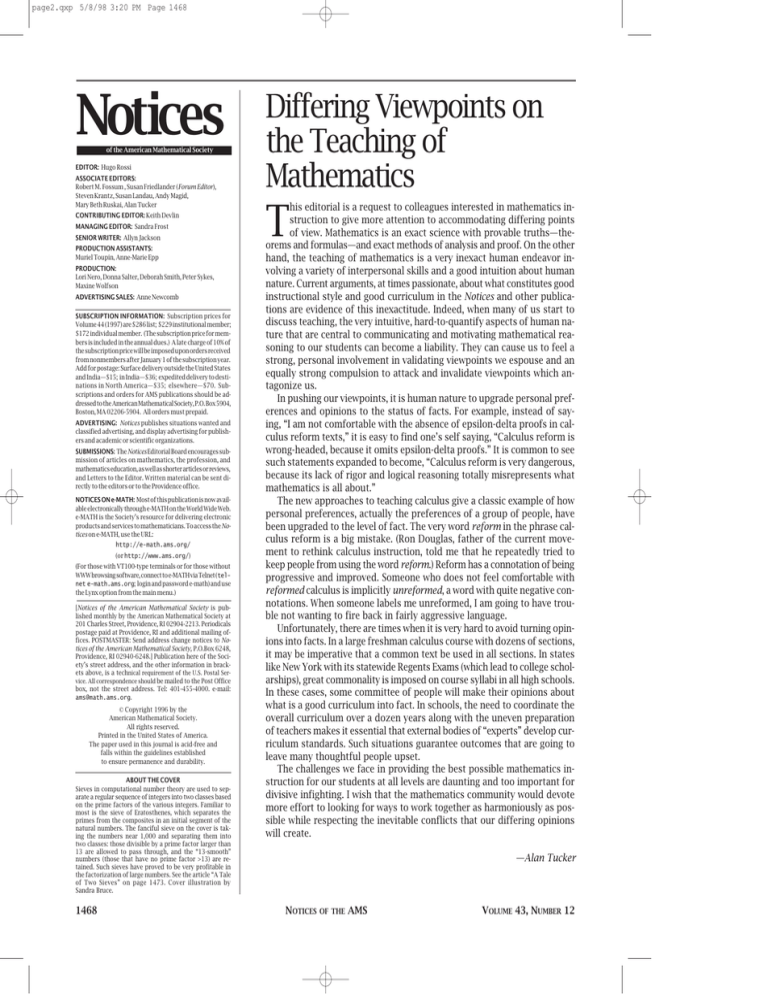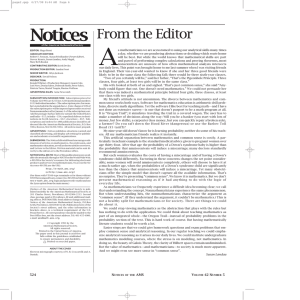
page2.qxp 5/8/98 3:20 PM Page 1468
Notices
of the American Mathematical Society
EDITOR: Hugo Rossi
ASSOCIATE EDITORS:
Robert M. Fossum , Susan Friedlander (Forum Editor),
Steven Krantz, Susan Landau, Andy Magid,
Mary Beth Ruskai, Alan Tucker
CONTRIBUTING EDITOR: Keith Devlin
MANAGING EDITOR: Sandra Frost
SENIOR WRITER: Allyn Jackson
PRODUCTION ASSISTANTS:
Muriel Toupin, Anne-Marie Epp
PRODUCTION:
Lori Nero, Donna Salter, Deborah Smith, Peter Sykes,
Maxine Wolfson
ADVERTISING SALES: Anne Newcomb
SUBSCRIPTION INFORMATION: Subscription prices for
Volume 44 (1997) are $286 list; $229 institutional member;
$172 individual member. (The subscription price for members is included in the annual dues.) A late charge of 10% of
the subscription price will be imposed upon orders received
from nonmembers after January 1 of the subscription year.
Add for postage: Surface delivery outside the United States
and India—$15; in India—$36; expedited delivery to destinations in North America—$35; elsewhere—$70. Subscriptions and orders for AMS publications should be addressed to the American Mathematical Society, P.O. Box 5904,
Boston, MA 02206-5904. All orders must prepaid.
ADVERTISING: Notices publishes situations wanted and
classified advertising, and display advertising for publishers and academic or scientific organizations.
SUBMISSIONS: The Notices Editorial Board encourages submission of articles on mathematics, the profession, and
mathematics education, as well as shorter articles or reviews,
and Letters to the Editor. Written material can be sent directly to the editors or to the Providence office.
NOTICES ON e-MATH: Most of this publication is now available electronically through e-MATH on the World Wide Web.
e-MATH is the Society’s resource for delivering electronic
products and services to mathematicians. To access the Notices on e-MATH, use the URL:
http://e-math.ams.org/
(or http://www.ams.org/)
(For those with VT100-type terminals or for those without
WWW browsing software, connect to e-MATH via Telnet (telnet e-math.ams.org; login and password e-math) and use
the Lynx option from the main menu.)
[Notices of the American Mathematical Society is published monthly by the American Mathematical Society at
201 Charles Street, Providence, RI 02904-2213. Periodicals
postage paid at Providence, RI and additional mailing offices. POSTMASTER: Send address change notices to Notices of the American Mathematical Society, P.O.Box 6248,
Providence, RI 02940-6248.] Publication here of the Society’s street address, and the other information in brackets above, is a technical requirement of the U.S. Postal Service. All correspondence should be mailed to the Post Office
box, not the street address. Tel: 401-455-4000. e-mail:
ams@math.ams.org.
© Copyright 1996 by the
American Mathematical Society.
All rights reserved.
Printed in the United States of America.
The paper used in this journal is acid-free and
falls within the guidelines established
to ensure permanence and durability.
ABOUT THE COVER
Sieves in computational number theory are used to separate a regular sequence of integers into two classes based
on the prime factors of the various integers. Familiar to
most is the sieve of Eratosthenes, which separates the
primes from the composites in an initial segment of the
natural numbers. The fanciful sieve on the cover is taking the numbers near 1,000 and separating them into
two classes: those divisible by a prime factor larger than
13 are allowed to pass through, and the “13-smooth”
numbers (those that have no prime factor >13) are retained. Such sieves have proved to be very profitable in
the factorization of large numbers. See the article “A Tale
of Two Sieves” on page 1473. Cover illustration by
Sandra Bruce.
1468
Differing Viewpoints on
the Teaching of
Mathematics
T
his editorial is a request to colleagues interested in mathematics instruction to give more attention to accommodating differing points
of view. Mathematics is an exact science with provable truths—theorems and formulas—and exact methods of analysis and proof. On the other
hand, the teaching of mathematics is a very inexact human endeavor involving a variety of interpersonal skills and a good intuition about human
nature. Current arguments, at times passionate, about what constitutes good
instructional style and good curriculum in the Notices and other publications are evidence of this inexactitude. Indeed, when many of us start to
discuss teaching, the very intuitive, hard-to-quantify aspects of human nature that are central to communicating and motivating mathematical reasoning to our students can become a liability. They can cause us to feel a
strong, personal involvement in validating viewpoints we espouse and an
equally strong compulsion to attack and invalidate viewpoints which antagonize us.
In pushing our viewpoints, it is human nature to upgrade personal preferences and opinions to the status of facts. For example, instead of saying, “I am not comfortable with the absence of epsilon-delta proofs in calculus reform texts,” it is easy to find one’s self saying, “Calculus reform is
wrong-headed, because it omits epsilon-delta proofs.” It is common to see
such statements expanded to become, “Calculus reform is very dangerous,
because its lack of rigor and logical reasoning totally misrepresents what
mathematics is all about.”
The new approaches to teaching calculus give a classic example of how
personal preferences, actually the preferences of a group of people, have
been upgraded to the level of fact. The very word reform in the phrase calculus reform is a big mistake. (Ron Douglas, father of the current movement to rethink calculus instruction, told me that he repeatedly tried to
keep people from using the word reform.) Reform has a connotation of being
progressive and improved. Someone who does not feel comfortable with
reformed calculus is implicitly unreformed, a word with quite negative connotations. When someone labels me unreformed, I am going to have trouble not wanting to fire back in fairly aggressive language.
Unfortunately, there are times when it is very hard to avoid turning opinions into facts. In a large freshman calculus course with dozens of sections,
it may be imperative that a common text be used in all sections. In states
like New York with its statewide Regents Exams (which lead to college scholarships), great commonality is imposed on course syllabi in all high schools.
In these cases, some committee of people will make their opinions about
what is a good curriculum into fact. In schools, the need to coordinate the
overall curriculum over a dozen years along with the uneven preparation
of teachers makes it essential that external bodies of “experts” develop curriculum standards. Such situations guarantee outcomes that are going to
leave many thoughtful people upset.
The challenges we face in providing the best possible mathematics instruction for our students at all levels are daunting and too important for
divisive infighting. I wish that the mathematics community would devote
more effort to looking for ways to work together as harmoniously as possible while respecting the inevitable conflicts that our differing opinions
will create.
—Alan Tucker
NOTICES
OF THE
AMS
VOLUME 43, NUMBER 12







